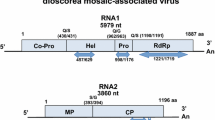Abstract
A virus-like dsRNA of about 23 kbp was detected in gentian plants showing Kobu-sho syndrome including stunting, shortened internodes, and tumors on stems, nodes and roots. Nucleotide sequence analysis has suggested that this dsRNA is related to Pestivirus species but not to any other plant viruses. It was protected from externally added RNase, suggesting that the dsRNA is encapsidated. The dsRNA was co-extracted in a crude homogenate of glutaraldehyde-fixed tissue with the virus-like particles that have been associated previously with Kobu-sho syndrome in gentian (Usugi et al. Jpn J Phytopathol 76:21–24, 2010). The RNA sequence was detected in more than 99 % of Kobu-sho gentian individuals but in less than 20 % of apparently healthy gentian individuals from fields affected with Kobu-sho. Thus, we propose naming the virus Gentian Kobu-sho-associated virus.




Similar content being viewed by others
References
Abe J, Takesawa T (2005) Characteristics of stem tissue on gentian tumorous symptoms (in Japanese). Ann Rept Plant Prot North Japan 56:65–69
Chiba K-I, Onoda K, Abe J, Iwadate Y, Takesawa T (2008) Graft transmission of gentian tumorous symptoms ‘Kobu-sho’ (in Japanese). Ann Rept Plant Prot North Japan 59:74–76
Chomczynski P, Sacchi N (1987) Single-step method of RNA isolation by acid guanidinium thiocyanate-phenol-chloroform extraction. Anal Biochem 162:156–159
Fukuhara T, Koga R, Aoki N, Yuki C, Yamamoto N, Oyama N, Udagawa T, Horiuchi H, Miyazaki S, Higashi Y, Takeshita M, Ikeda K, Arakawa M, Matsumoto N, Moriyama H (2006) The wide distribution of endornaviruses, large double-stranded RNA replicons with plasmid-like properties. Arch Virol 151:995–1002
Gibbs MJ, Koga R, Moriyama H, Pfeiffer P, Fukuhara T (2000) Phylogenetic analysis of some large double-stranded RNA replicons from plants suggests they evolved from a defective single-stranded RNA virus. J Gen Virol 81:227–233
Grimsley N, Hohn B, Hohn T, Walden R (1986) “Agroinfection,” an alternative route for viral infection of plants by using the Ti plasmid. Proc Natl Acad Sci USA 83:3282–3286
Hoshi A, Oshima K, Kakizawa S, Ishii Y, Ozeki J, Hashimoto M, Komatsu K, Kagiwada S, Yamaji Y, Namba S (2009) A unique virulence factor for proliferation and dwarfism in plants identified from a phytopathogenic bacterium. Proc Natl Acad Sci USA 106:6416–6421
Iwadate Y, Takesawa T, Chiba K-I, Tada K (2006) “Kobu-sho” syndrome of gentian (in Japanese). Plant Prot (Shokubutu boueki) 60:518–522
Kadare G, Haenni AL (1997) Virus-encoded RNA helicases. J Virol 71:2583–2590
Kadota I (2008) Immunohistochemistry analysis of the tissues of gentian plants using the antiserum to the bacterium isolated from roots of ‘Kobu-sho’ syndrome of gentian (Abstract in Japanese). Jpn J Phytopathol 74:54
Kadota I, Ohto Y, Yoshida T, Okada H, Ishiguro K, Hagiwara H (2005) Growth inhibition of gentian roots (Gentiana spp.) developed in the ‘Kobu-sho’ plants which formed warts on the basal petioles, and bacteriological properties of the bacteria isolated from the roots (Abstract in Japanese). Jpn J Phytopathol 71:291
Kadota I, Shinohara H, Nagasaka A, Kaku H (2006) Growth inhibition of gentian by inoculation with the bacteria isolated from roots representing tumor (Kobu-sho) on stem of gentian (Abstract in Japanese). Jpn J Phytopathol 72:56
Kobayashi K, Tomita R, Sakamoto M (2009) Recombinant plant dsRNA-binding protein as an effective tool for the isolation of viral replicative form dsRNA and universal detection of RNA viruses. J Gen Plant Pathol 75:87–91
Kodama K, Naito Y, Chiba K-i, Katsube K, Fujiwara K, Umesawa M (2004) On the incidence of gentian Kobu-sho in Iwate Prefecture (Abstract in Japanese). Abstract H16, Proceedings of Tohoku Meeting of Japanese Soc Hortic Sci, pp 51–52
Koonin EV (1991) The phylogeny of RNA-dependent RNA polymerases of positive-strand RNA viruses. J Gen Virol 72:2197–2206
Page RD (1996) TreeView: an application to display phylogenetic trees on personal computers. Comput Appl Biosci 12:357–358
Ronquist F, Huelsenbeck JP (2003) MrBayes 3: Bayesian phylogenetic inference under mixed models. Bioinformatics 19:1572–1574
Sambrook J, Fritsch EF, Maniatis T (1989) Molecular cloning: a laboratory manual, 2nd edn. Cold Spring Harbor Laboratory Press, Cold Spring Harbor
Schneider WL, Roossinck MJ (2001) Genetic diversity in RNA virus quasispecies is controlled by host–virus interactions. J Virol 75:6566–6571
Takahashi H, Munemura I, Nakatsuka T, Nishihara M, Uchimiya H (2009) Metabolite profiling by capillary electrophoresis-mass spectrometry reveals aberrant putrescine accumulation associated with idiopathic symptoms of gentian plants. J Hortic Sci Biotechnol 84:312–318
Takesawa T, Abe J (2005) Characterization of components extracted from nodal tumours in plants with gentian tumorous symptoms (in Japanese). Ann Rept Plant Prot North Japan 56:70–73
Takesawa T, Chiba K-I, Iwadate Y, Abe J (2006) Gentian tumorous symptoms are transmitted by grafting and are not observed by shoot apex culture (in Japanese). Ann Rept Plant Prot North Japan 57:68–71
Tamura K, Peterson D, Peterson N, Stecher G, Nei M, Kumar S (2011) MEGA5: molecular evolutionary genetics analysis using maximum likelihood, evolutionary distance, and maximum parsimony methods. Mol Biol Evol 28:2731–2739
Usugi T, Hibino H, Tanaka M, Kodama K, Takesawa T, Chiba K, Iwadate Y (2010) Virus-like particles observed in plants with gentian tumorous symptoms (in Japanese). Jpn J Phytopathol 76:21–24
Acknowledgments
We thank Kazue Obara for technical assistance and Dennis Murphy for English editing. This work was supported mainly by the government of Iwate Prefecture and partly by Ehime University.
Author information
Authors and Affiliations
Corresponding author
Electronic supplementary material
Below is the link to the electronic supplementary material.
Rights and permissions
About this article
Cite this article
Kobayashi, K., Atsumi, G., Iwadate, Y. et al. Gentian Kobu-sho-associated virus: a tentative, novel double-stranded RNA virus that is relevant to gentian Kobu-sho syndrome. J Gen Plant Pathol 79, 56–63 (2013). https://doi.org/10.1007/s10327-012-0423-5
Received:
Accepted:
Published:
Issue Date:
DOI: https://doi.org/10.1007/s10327-012-0423-5




